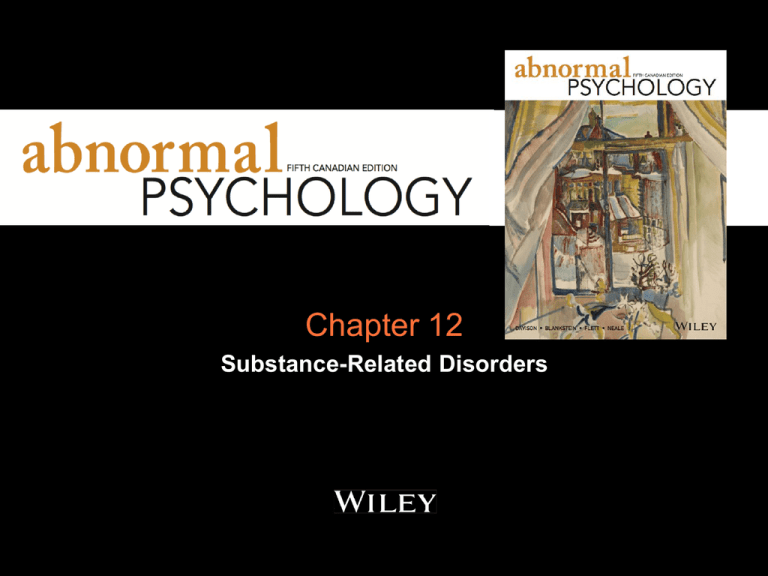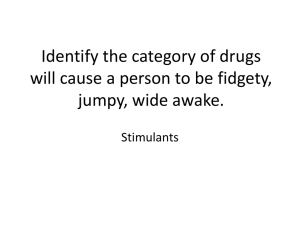
Chapter 12
Substance-Related Disorders
Chapter Outline
•
•
•
•
•
•
•
•
•
•
Key Terms – Substance-related and addictive
disorders
Alcohol
Inhalant Use Disorder
Nicotine and Cigarette Smoking
Marijuana
Sedatives and Stimulants
LSD and Other Hallucinogens
Etiology
Therapy
Prevention of Substance Use
Substance-related and addictive
disorders
•
•
Key terms: DSM-IV-TR
Substance Dependence
•
•
•
Tolerance: larger doses are needed to get same desired effect
Withdrawal: negative physical and/or psychological effects
when person stops taking the drug
Substance Abuse
considered to be less serious
must have experienced one of the following as a result
of recurrent use:
•
•
•
•
•
•
Failure to fulfill major obligations
Exposure to physical dangers
Legal problems
Persistent social or interpersonal problems
Substance Related and Addictive
Disorders (DSM-5)
•
•
•
Eliminated DSM-IV-TR classifications of
dependence and abuse since the distinction
was considered to be one of severity not
distinct categories
DSM-5 has single broad category of
substance-related and addictive disorders
Addictions now include ‘gambling disorders’
Alcohol Dependence
•
Alcohol dependence may include tolerance or withdrawal
reactions
•
•
People who are physically dependent on alcohol tend to have
more severe symptoms of the disorder
Alcohol dependence is often part of polydrug (or
polysubstance) use
•
•
•
Using more than one drug at a time
Effects of drugs can be synergistic (combine to produce very
strong reaction)
Potentially fatal overdoses (i.e., alcohol can reduce amount of
narcotics needed to make a lethal dose)
Alcohol Dependence
Prevalence and Comorbidity
•
Alcohol dependence
•
•
•
•
•
Lifetime prevalence rate: 12.5%
12-month prevalence: 3.8%
Higher among men, younger cohorts and whites
Comorbid with mood and anxiety disorders, other
drug use and schizophrenia
Comorbidity (psychiatric disorders and substance
dependence) is important because:
•
•
predicts high relapse rates
less initial treatment improvement
High Risk Drinking
•
•
•
Defined as more than two drinks per day
Higher rates in men (25.1%) compared to women
(8.9%)
Prototypic heavy drinker in Canada:
•
•
•
Male
Not married
Relatively well-off financially
Binge Drinking at University
•
•
•
•
•
•
1 in every 4 university students is a frequent binge
drinkers (usually once per week) (US stats)
32% of undergraduates report hazardous or harmful
patterns of drinking (compare to 17% in the general
population)
More Canadian students drink some alcohol;
American students who use alcohol are heavier
drinkers
First experience of drunkenness prior to age 16 is more
likely to lead to heavy drinking later
1 in 4 Ontarians in grades 7 to 12 admit binge drinking
within last month – no gender differences was found
Short-Term Effects of Alcohol
•
•
•
•
Metabolized by enzymes after swallowed and enters
stomach
Most goes into small intestines where absorbed into
blood
Broken down in liver
•
•
can metabolize about 30 millilitres of 100-proof (50% alcohol)
whisky/hour
quantities in excess of this amount stay in the bloodstream
Biphasic effect
•
•
Initial effect of alcohol: acts as a stimulant
Later effect of alcohol: acts as a depressant
Short-Term Effects of Alcohol
Biological Mechanism
•
Produces effects through interactions with
several neural systems in the brain
Stimulates GABA receptors
•
• Reducing tension
• Increases levels of serotonin and dopamine
• Pleasurable effects
• Inhibits glutamate receptors
•
Cognitive effects of alcohol intoxication, such as
slurred speech and memory loss
Long-Term Effects
•
•
Chronic drinking causes severe biological
damage and psychological deterioration
Almost every tissue and organ is adversely
affected:
Malnutrition
Deficiency of B-complex vitamins → amnestic
syndrome
Cirrhosis of the liver
Damage to the endocrine glands and
pancreas
Heart failure, hypertension, stroke, and
capillary hemorrhages, which in turn can
produce:
Brain damage
•
•
•
•
•
•
Fetal Alcohol Syndrome
•
•
•
•
•
Leading cause of mental
retardation— heavy alcohol
consumption during pregnancy
growth of the fetus is slowed
cranial, facial, and limb
anomalies are produced
known as fetal alcohol
syndrome
see also partial fetal alcohol
syndrome and alcohol-related
neurodevelopmental disorder
(ARND)
Inhalant Use Disorders
•
Although use not confined to children and
adolescents, alarming # of young people begin their
substance abuse by inhaling substances
Glue, correction fluid, spray paint, cosmetics,
gasoline, household aerosol sprays, nitrous oxide
found in spray cans of whipped cream
Inhalant use among young people = 17.3%
•
•
Nicotine Use and Cigarette Smoking
•
•
•
Single most preventable cause of premature
death (1 in every 5 deaths)
Nicotine— addictive ingredient of tobacco
stimulates nicotinic receptors in brain
facilitate release of neurotransmitter
dopamine
produces reinforcing (pleasurable) effects
Harmful components of cigarettes include:
nicotine, carbon monoxide and tar
•
•
•
Health Consequences
•
Medical problems associated with cigarette
smoking include:
•
•
•
•
Lung cancer
Emphysema
Cancer of larynx and esophagus
Cardiovascular diseases
Smoking Statistics
•
In 2009, ~17% of Canadians aged 15 > are current
smokers
•
•
•
•
•
But fewer Canadians are smoking and smokers are
smoking fewer cigarettes on a daily basis
Men smoke more cigarettes per day than women
Rates of smoking have declined steadily overall
among teenagers in Canada except for increased
rates in Quebec (where 1 in 5 smoke)
Second hand smoke (toxic exposure to
environmental tobacco smoke) causes more than
50,000 deaths per year (USA)
Children with second hand smoke exposure showed:
•
•
self-reported aggression
teacher-rated anti-social behaviour
Marijuana
•
•
•
Marijuana—dried and crushed leaves and flowering tops
of Cannabis sativa
•
Major active chemical is delta-9-tetrahydrocannabinol (THC)
Psychological Effects of Marijuana
•
•
•
Feel more relaxed and sociable
Can dull attention, fragment thoughts, and impair memory
Extremely heavy doses can induce hallucinations and extreme
panic
Somatic Effects
•
Specific cannabinoid receptors in brain (CB) have been located
in various brain regions
receptors in hippocampus may account for short-term
memory loss effects following marijuana use
•
•
Therapeutic Effects
•
Reduce nausea and appetite loss that accompanies
chemotherapy
Sedatives
•
Sedatives (‘downers’) slow activities of body and reduce
responsiveness.
Includes opiates—opium and its derivatives,
morphine, heroin, and codeine
and synthetic barbiturates and tranquilizers, such as
secobarbital (Seconal) and diazepam (Valium)
Group of drugs used medically (in moderate doses) to
relieve pain and induce sleep
•
•
•
•
•
•
•
•
•
•
•
•
Sedatives (Cont.)
Psychological and Physical Effects
Opium and derivatives (morphine and heroin)
produce:
Euphoria, drowsiness, daydream, and lack of
coordination
Heroin has an additional initial effect— the rush
Effects produced by stimulating neural receptors of
the body’s own opioid system
Heroin (example) converted into morphine in brain
and then binds to opioid receptors
Body produces opioids (endorphins and enkephalins)
Opium and derivatives fit into receptors and stimulate
them
In 24-year follow-up of 500 heroin addicts
28% had died by age 40
•
•
•
•
•
•
•
•
Stimulants
Stimulants (‘uppers’) such as cocaine, act on brain
and sympathetic nervous system to increase
alertness and motor activity
Amphetamines
Originally used to control control mild depression
and appetite
Today used to treat hyperactive children
Examples: Benzedrine, Dexedrine, and
Methedrine
Produce effects by causing the release of
norepinephrine and dopamine and blocking the
reuptake of these neurotransmitters
Cocaine
Pleasure induced by cocaine related to has
blocked dopamine reuptake
LSD and Other Hallucinogens
•
•
•
LSD= d-lysergic acid diethylamide
LSD is a hallucinogen
•
•
Main effect of drug is hallucinations
Other effects include flashbacks
Other important hallucinogens are:
•
•
•
Mescaline
Psilocybin
Synthetic compounds MDA and MDMA
Etiology of Substance Use and
Dependence Disorders
Psychological Variables
•
•
Role of cognition
Positive expectations predict use
Expectancies:
Drinking helps one cope with stress
Drinking enhances sexual pleasure
Personality
Novelty-seeking is associated with alcohol
dependence
Psychoticism and anti-social traits associted
with drug use
•
•
•
•
•
•
Biological Variables
•
•
•
Evidence for genetic predisposition for alcohol abuse
Research: identical twins more likely than fraternal
twins to have concordance for alcohol, caffeine,
nicotine and heavy cannabis and drug use
Conditioning theory of tolerance— underscores need to
jointly consider biological processes and environmental
stimuli
•
•
•
•
Based on notion that tolerance is a learned response
Environmental cues present when addictive behaviours are
developed influence behaviours because these cues come to be
associated with substance use (classical conditioning)
Feedforward mechanisms— regulatory responses
made in anticipation of a drug
We learn to anticipate drug effects even before they
actually occur
•
Therapy
Admitting the Problem
•
•
•
•
•
•
•
Do you sometimes feel uncomfortable when alcohol is not
available?
Do you drink more heavily than usual when you are under
pressure?
Are you in more of a hurry to get to the first drink than you used to
be?
Do you sometimes feel guilty about your drinking?
Are you annoyed when people talk about your drinking?
When drinking socially, do you try to sneak in some extra drinks?
Are you constantly making rules for yourself about what and when
to drink?
• Traditional Hospital Treatment
• Detoxification
• Biological Treatments
• Example: disulfiram (Antabuse)
• Alcoholics Anonymous
Therapy (Cont.)
12 Steps of AA
Therapy (cont.)
•
•
•
Couples and Family Therapy
Adolescent Treatment Centre
Cognitive and Behavioural Treatment
Aversion Therapy
•
•
•
•
Covert sensitization
Contingent-Management Therapy
•
emphasizes patient control and includes:
•
•
•
Stimulus control
Modification of the topography of drinking
Reinforcing abstinence
Moderation in Drinking
•
•
Controlled drinking
Harm reduction therapy
Therapy for Use of Illicit Drugs
•
•
Detoxification—central to treatment of people
who use addicting drugs
Biological Treatments
Heroin substitutes
•
•
•
•
•
Drugs chemically similar to heroin that replace
body’s craving
Example: methadone, levomethadyl acetate,
bupreorphine
Heroin antagonists
•
Drugs that prevent user from experiencing heroin
high
Psychological Treatments
CBT and Motivational Interviewing
•
Therapy for Smoking
•
•
Biological Treatment
•
Nicotine replacement therapy
Nicotine gum, patches, inhalers etc.
•
Psychological Treatment
•
•
Various coping strategies (relaxation, positive self-talk)
Evidence for combined approaches (counseling and biological
interventions)
Prevention
•
•
•
•
Peer-pressure
resistance training
Correction of
normative
expectations
Inoculation against
mass-media
messages
Information about
parental and other
adult influences
•
•
•
Peer leadership
Affective education,
self-image
enhancement.
Other components
•
•
Providing information
about harmful effect
Encouraging students
to make public
commitment not to
smoke
Copyright
•
Copyright © 2014 John Wiley & Sons Canada, Ltd. All rights
reserved. Reproduction or translation of this work beyond that
permitted by Access Copyright (The Canadian Copyright
Licensing Agency) is unlawful. Requests for further information
should be addressed to the Permissions Department, John
Wiley & Sons Canada, Ltd. The purchaser may make back-up
copies for his or her own use only and not for distribution or
resale. The author and the publisher assume no responsibility
for errors, omissions, or damages caused by the use of these
programs or from the use of the information contained herein.









